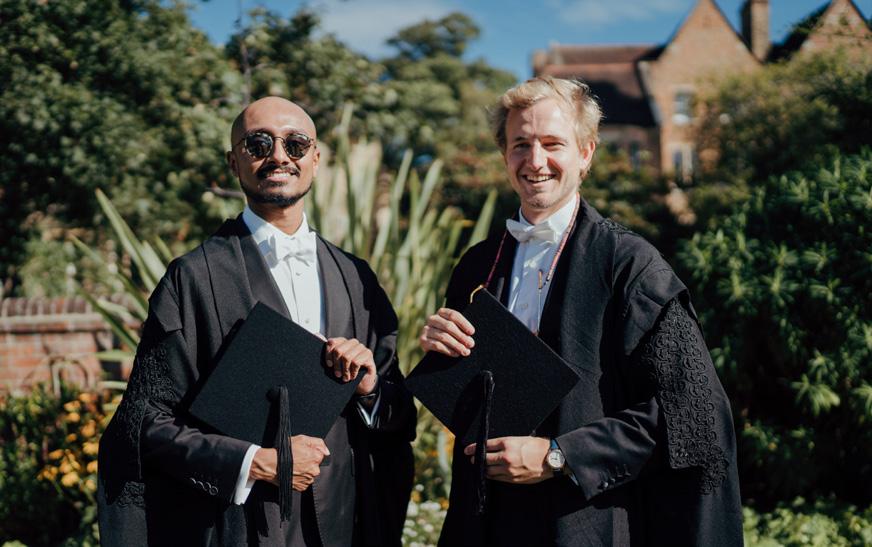CONNECT

The magazine of Kellogg College | 2022


The magazine of Kellogg College | 2022
We’re committed to making as little impact on the environment as possible. That’s why this magazine has been printed on FSC certified papers using vegetable inks by a company that holds ISO14001 certification and has carbon offset the paper used in this publication. If you have received this magazine via post but would rather, in future, receive an electronic copy, please email: alumni@kellogg.ox.ac.uk
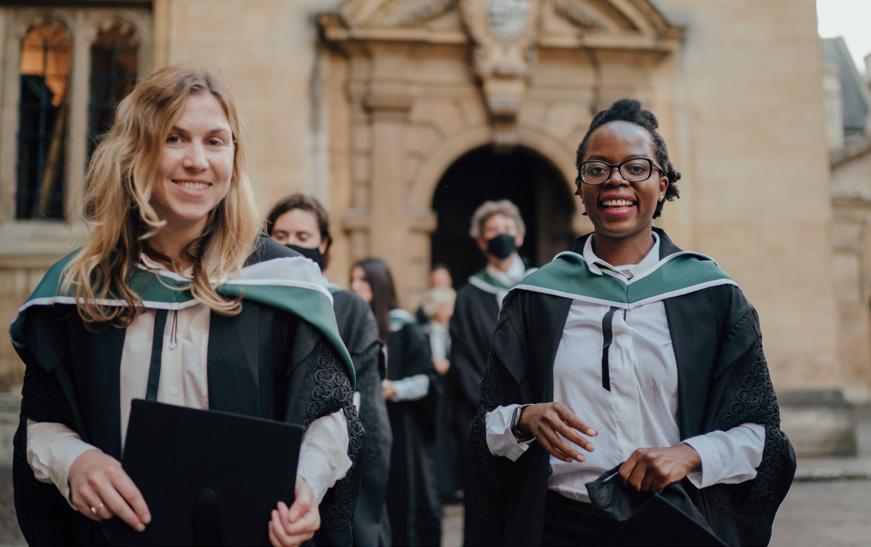
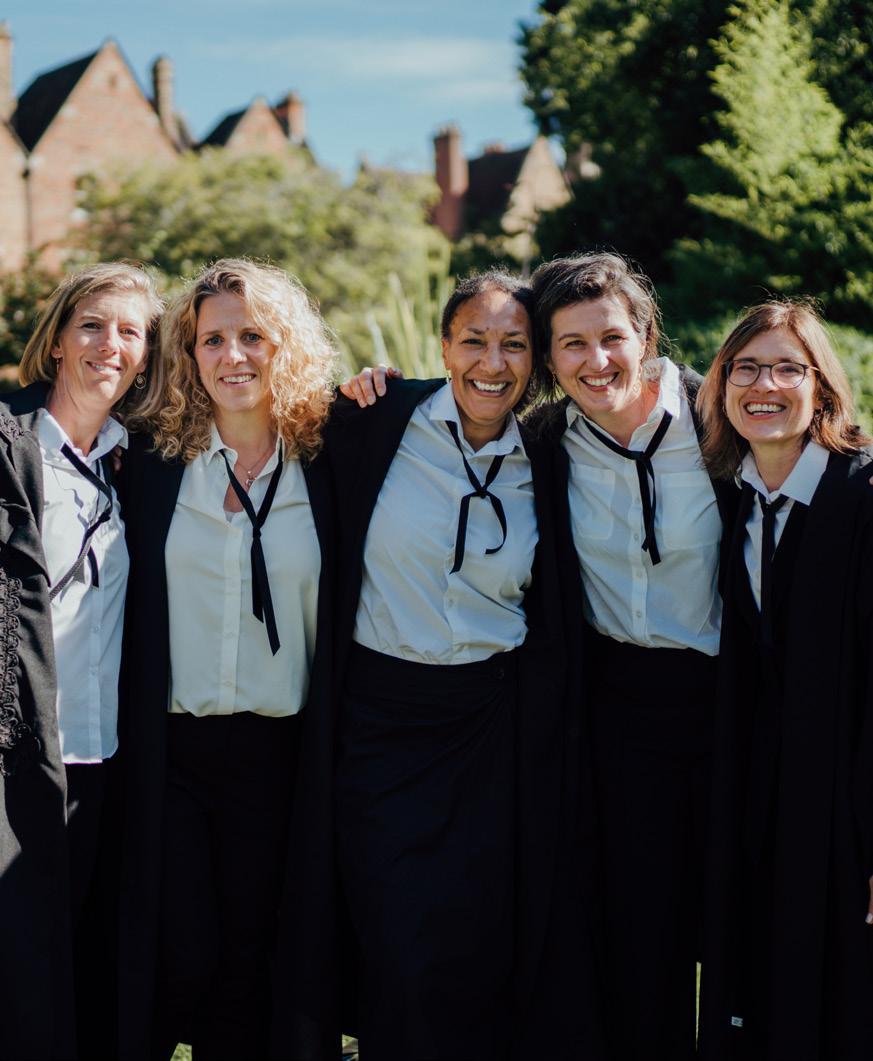
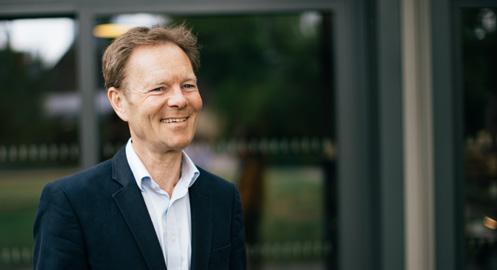
From adversity to success – creating opportunities and making an impact
Our College champions lifelong learning. For those who weren’t able to study for a Master’s or doctoral degree in their 20s, it’s never too late to learn. While the Covid-19 pandemic caused terrible problems, we ensured our students remained engaged. And College members created opportunity out of adversity. The cover photo of this year’s edition of the magazine shows our Fellow Dr Reuben Binns demonstrating the workings of the Enigma machine during our annual Bletchley Park Week. As his article in this issue describes, this was the Enigma machine that Reuben had constructed at home during lockdown.
Our Bletchley Park Week also welcomed teachers and pupils from East Oxford Primary School to see one of the original Enigma machines demonstrated, on loan from Bletchley Park in our College
Hub. The school reported the visit had been transformative for their pupils. We followed up by creating a link with the school, to support them and their community, and we look forward to engaging with them further.
The positive impact our College has across the University, in the community, and globally continues to advance at a remarkable rate, despite the pandemic. Indeed, one of the last activities before the first lockdown was to hear HRH The Prince of Wales say what an honour it was to have been made a Fellow, and how important he regarded the work of our Global Centre on Healthcare and Urbanisation. Following that visit, we launched our Commission on Creating Healthy Cities, in partnership with The Prince’s Foundation. This was generously funded by the McCall MacBain Foundation, Dr Ralph
Walter, and Halley Liu, with Lord Best as Chair. We are immensely grateful to them all. The Commission’s Report and recommendations will undoubtedly have an importantly positive impact. We will make it so.
While our Fellows have been winning awards, spinning out companies, and even recreating the Enigma machine during lockdown, behind the scenes we have continued to advance our plans to expand and develop the College grounds and gardens, acquiring additional villas, and building additional student accommodation and state of the art facilities. From adversity to opportunity, from setbacks to success.
Professor Jonathan Michie President, Kellogg College
Among the tens of thousands of people attending the COP26 climate conference were a number of Kellogg members, each playing their own part in the push to net zero. Here four share their experiences, lessons learnt and what they take away with them from the conference.
COP26 (AKA the 26th Conference of Parties of the United Nations Framework Convention on Climate Change) was a vast event lasting two weeks and encompassing a number of interconnected sub-conferences. The conference included official multilateral negotiations; presentations on myriad climate topics by academics, professionals, and representatives from communities; protests and demonstrations, both within and outside the conference centre; artistic performances; and much more.
Despite severe Covid-19 travel limitations and on-site restrictions this year, COP26 in Glasgow probably had the highest attendance of any previous COP, with nearly 40,000 people registered as participants. Among those tens of thousands were several Kellogg members – including two of our distinguished Bynum Tudor Fellows: Lord Bilimoria in his role as President of the CBI, and His Royal Highness, The Prince of Wales, supporting the Glasgow Financial Alliance for Net Zero, encouraging banks and other financiers to pledge to use their power to push those they fund towards net zero. Prince Charles spoke at the opening
ceremony, concluding with this ringing call to action: “The cost of inaction is far greater than the cost of prevention. So, I can only urge you, as the world’s decision-makers, to find practical ways of overcoming differences so we can all get down to work, together, to rescue this precious planet and save the threatened future of our young people.”
Identifying and constructing those practical ways forward that HRH Prince of Wales refers to takes hard, detailed, tireless work. Among those taking part in this work are two Kellogg alumni and two Kellogg Fellows. Here they share their impressions of COP26.

I attended COP26 wearing three hats – as Visiting Fellow at the Global Centre on
Healthcare and Urbanisation (GCHU) at Kellogg College, as a COP26 Climate Resilience Fellow at Cambridge ZERO, and as a Net Zero Associate at WSP where I lead the cities team. Decisions made at the climate conference influence each of my roles, as cities are at the heart of the net zero transition and COP26 was an opportunity to secure global commitments on urban climate action this decade.
I work with cities around the world to design and implement ambitious, evidence-based net zero strategies. Cities have a significant role to play in the net zero transition, given they are home to most of the global population and are nodes for economic, social, and political activity. As nations commit to more ambitious climate targets and enhanced resilience within urban areas, there are ramifications at the city level where these ambitions are often realised. It’s therefore critical that I’m aware of these changing commitments, to communicate with the cities I am advising as well as the academics and practitioners with whom I collaborate.
What was the result of COP26 for cities? Firstly, countries’ carbon reduction targets
weren’t changed. This means that cities are not legally obliged to go beyond national government carbon reduction commitments.
Secondly, over 40 countries have agreed to ‘phase down’ fossil fuel use, which is a significant milestone as it’s the first time fossil fuels have been explicitly mentioned. In many cases, this gives cities the mandate to justify investments in alternative low carbon energy.
Thirdly, climate finance is required to enhance urban resilience and reduce carbon emissions – and although there was no additional finance provided at COP26, nations have committed to $100 billion by 2025. So, cities will have to explore different funding sources, mechanisms, and approaches to realise their climate ambitions.
Working directly with cities today, it is interesting to note that many of them are going beyond national carbon reduction commitments and aiming for net zero by 2030 or 2040. We are seeing ambitious urban policies, programmes, and projects being implemented across the globe.
Although some national government progress was made at COP26 with the
Glasgow Climate Pact, in many cases addressing the climate crisis rests with the cities that are already delivering climate action and reaching net zero targets ahead of the curve.
Local governments can be nimbler and can respond much faster to climate change than national government; let’s hope that COP27 stretches the Nationally Determined Contributions to give more cities the impetus to deliver change on the ground.

Dr Ana Nacvalovaite, Kellogg alumna and Research Fellow
MSt in International Human Rights Law (2011), DPhil on Regulation of Sovereign Wealth Funds (2018).
Wednesday 3 November was ‘Finance Day’ at COP26, a day when government
and private sector representatives engaged on building sound foundations with the financial sector to achieve global climate goals. I am heavily involved in sustainable finance in my work, serving as an expert advisor on the BSI (British Standards Institution) Committee of Experts on Sustainable Finance. I am also a member of the working group of ISO TC322, ‘Sustainable Finance Framework’, and I have participated in drafting and reviewing International Standards on Green Instruments.
At COP26 I participated in the BSI panel discussion on ‘How Standards for Sustainable Finance can Help Integrate Net Zero and ESG (Environmental Social Governance) Considerations into Investment Decisions’ with Ivan McKee, MSP, Minister for Business, Trade, Tourism, and Enterprise. The discussions highlighted the importance of a just transition and the need for sustainable finance to support the ‘S’ – social – in ESG. My overriding impression was that the world of finance is understanding and keen to guide the way for investment businesses, and ensuring that environmental agenda is a top priority.
The will is there, but the complexities of standardising regulation are significant and ensuring that everyone works together is paramount. However, the day drove significant progress on engagement of all stakeholders in ESG and SDGs (Sustainable Development Goals), although standardising regulation is still challenging, there is clear understanding for the need to do so. Governments, private sector, and academic community are all hoping to see positive and imminent changes coming out from standing united on finding solutions that are global, inclusive, and manageable.
From April 2022 I have been a Research Fellow working with Professor Jonathan Michie on a three-year research project in Kellogg’s Centre for Mutual & Co-owned Business, investigating whether sovereign wealth funds might focus investments globally on local co-operatives as a way of enhancing social and environmental sustainability. We hope to identify ways in which this would enable these huge funds to be used actively to pursue Sustainable Development Goals, including SDG 13 to ‘Take action to combat climate change and its impacts’.

Attending a COP can be an overwhelming but also fulfilling experience. I attended COP26 in two capacities. First, I chaperoned two undergraduate students from Swarthmore College, a liberal arts college located near Philadelphia, US, where I previously worked as an Office of Sustainability staff member. These students have focused their studies on climate policy, environmental justice, and related topics. I was grateful to attend COP26 with these two incredibly bright and passionate students who were representing South American and US island territory communities.
Second, I was also in attendance as a student myself. I am currently a second year PhD candidate at Princeton University’s School of Public & International Affairs, where I focus my research on climate adaptation policy. I track, assess, and develop such policy from a US perspective – at the federal level, in the urban Mid-Atlantic region of the country where I have lived my whole life, and in terms of US interaction on the global stage. I refer to this work as ‘multi-level climate governance’, and I began exploring it when I was a part-time, distance-learning MSc student at Kellogg studying Sustainable Urban Development. At COP26 what had the greatest impact on me was observing the difference – at least among US delegates – in this first COP of the Biden Administration. I was thrilled, for example, to see that the subnational network of cities, tribal nations, businesses, universities, and others that had come together during the Trump Administration years was being honoured by the new federal team and incorporated into nascent policy developments. As part of these more multi-level conversations, I also observed far more discussion
throughout the COP about climate adaptation and similar concepts than ever before – an area which I see as a critical addition to necessary, ongoing mitigation efforts.
Ending with a note of both caution and hope, it is important to recognise what COPs are for and how they are limited. At their core, COPs are negotiating sessions among official country delegates – and the agendas for these negotiations are always extremely technocratic and rather slowmoving. These agenda items are actually quite important, but the contrast between their minutiae and the monumental scale of the climate crisis can feel disheartening. COPs are also places where global inequities play out on a condensed scale – where access and power influence the negotiation outcomes. But COPs can also offer radical, invigorating, and restorative convening spaces, often beyond the official negotiation sessions. And for that I am grateful.

As a Junior Research Fellow at Kellogg, I work as a transport-energy systems researcher on Climate Compatible Growth (CCG) – a large research programme on unlocking climate-compatible economic growth pathways for countries in the Global South, sponsored by the Foreign, Commonwealth & Development Office (FCDO).
My research looks at the challenges and opportunities of integrating sustainable transport systems with high-renewables electricity systems in accelerating transport-energy decarbonisation pathways in different contexts around the world. I’m leading a collaboration between the CCG
programme and the Asian Development Bank (ADB) in a series of working papers on the effective integration of e-mobility (electric cars, buses, motorcycles, bikes, and three-wheelers) and clean electricity production in South East Asia. The first working paper, which highlights the ‘winwin’ solutions available in decarbonising transport and electricity supplies whilst improving access to energy and mobility, was launched as part of our series of CCG side events at COP26 in Glasgow. We were delighted to see that these events attracted a series of high-profile attendees including senior economists, transport specialists and policymakers from energy ministries across the world.
Following the positive reception at COP26, we’re focussing on practical next steps in creating enabling environments for e-mobility and renewable energy integration, looking at Laos as a case study. We’re working with staff from the ADB and the UN Environment Programme, and researchers at the National University of Laos. Stay tuned at climatecompatiblegrowth.com
As part of Kellogg’s Global Centre on Healthcare and Urbanisation, the Commission on Creating Healthy Cities is exploring the most impactful ways to generate more sustainable urban environments.
With an ever-increasing proportion of the global population living in densely populated urban environments, city design – and how it impacts the health and wellbeing of its residents – has never been more important, particularly in light of infectious disease outbreaks such as the Covid-19 pandemic.
The Commission on Creating Healthy Cities, established in 2020 by Kellogg’s Global Centre on Healthcare and Urbanisation (GCHU) and co-hosted by The Prince’s Foundation, was born out of a need for better, more integrated cities that enhance the lives of those who live there.
“With the outbreak of Covid-19 it was
recognised immediately that cities needed to be made healthier, both in the sense of promoting and supporting wellbeing, and being as resilient as possible in the face of such pandemics,” explains Jonathan Michie, President of Kellogg. “We were fortunate that Lord Best agreed to chair the Commission on Creating Healthy Cities, and most grateful to all those who have served as commissioners, sub-group members, on the International Advisory Board, and who submitted evidence and participated in the wide range of expert groups and other factfinding activities.”
The Commission has gathered a group of international thought leaders involved in
healthcare and urbanisation, and includes three subgroups focusing on the built environment, design and place-making; transport and movement, infrastructure and technology; and health and wellbeing. An International Advisory Board, chaired by Lord Crisp, includes Bynum Tudor Fellows Dr Phumzile Mlambo-Ngcuka and La June Montgomery Tabron.
Lord Best says, “We’ve brought together leading academics, business people, and city experts to explore the links between health and wellbeing on the one hand, and urban design and planning on the other –from transport and infrastructure, to housing and the built environment.
“Over the last hundred years, the art of placemaking has been deliberately forgotten. The forces of rapid urbanisation and climate change, and natural resource depletion are so great that now is the time for different professions to combine together to help solve these critical issues.”
His Royal Highness, The Prince of Wales, Kellogg Bynum Tudor Fellow
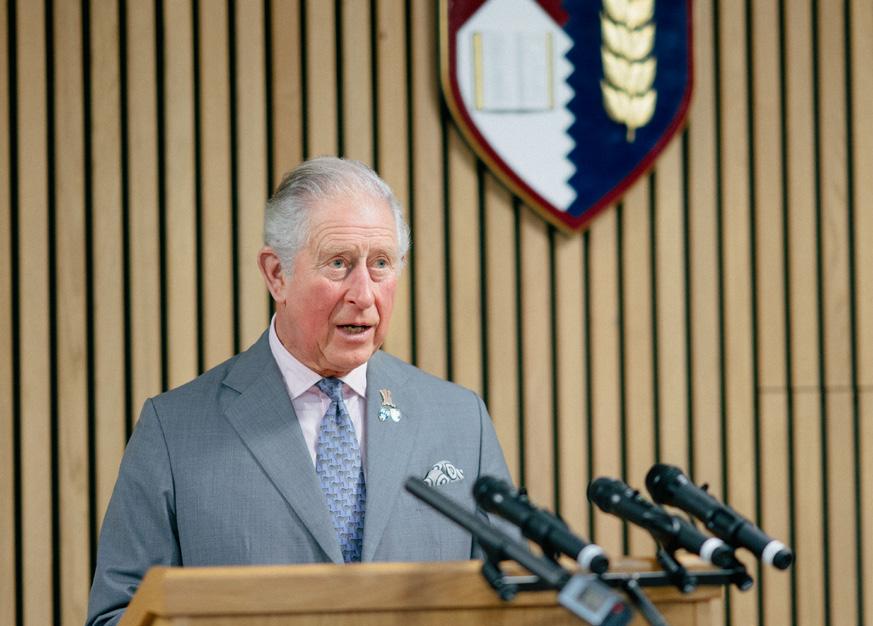
“By working together we’re able to make recommendations on the best ways to make cities environmentally, economically, and socially sustainable to provide environments that support and sustain the health and wellbeing of their residents and visitors.”
Ultimately the Commission will make recommendations for shaping future developments and adapting existing ones, so they become more resilient to infectious disease outbreaks. It is an important part of the GCHU’s work.
“GCHU’s involvement in the Commission on Creating Healthy Cities has been an invaluable opportunity for bringing together the Centre’s core interests in health and
sustainable urban development,” says Juliet Carpenter, Research Fellow at GCHU.
“We have been working with top experts nationally and internationally and we’re looking forward to the launch of the Report and Healthy Cities Toolkit in July.”
A key outcome of the Commission is a Healthy Cities Toolkit, designed to assist policy makers and practitioners in the UK – including local and central government, town planners, architects, urban designers, and those involved in creating our built environment.
The Toolkit is open to anyone with
an interest in the connections between urban design, city living, and matters of health. Users will be able to filter by type of intervention, resource implications (including cost), impact, and quality of evidence. The GCHU will host and keep updated this Healthy Cities Toolkit, as a lasting and important legacy of the Commission’s work.
“The Healthy Cities Toolkit is an accessible summary of urban health evidence that will assist practitioners, policy-makers, and the public to improve the health of people living and working in cities,” says Dr Georgia Richards, one of the post-doctoral Research Fellows working
“It has been so inspiring and encouraging to see how the framework of racial equality has been present and salient in all the conversations on the Commission. There is already a great deal of innovation occurring in how representatives from all over the world are dealing with the structural systems that create disparities. We all see the value of authentically connecting to the communities we serve and being proximate to the people in our communities who have ideas on how lasting change can happen that will ensure that every child and every family can truly thrive.”
La June Montgomery Tabron, The Commission International Advisory Board and Kellogg Bynum Tudor Fellow

for the Commission. “The Toolkit is a new and exciting way to share information and showcase what solutions may work by systematically grading their impact, resource implications, and the quality of the evidence.” It is now live and can be seen here: www.healthycitiescommission.org
In its approach to evidence-gathering, the Commission has taken a holistic view of the issues, recognising the backdrop of the climate crisis and the impact of factors such as poverty and diversity. A two-pronged approach was taken to gather evidence. Firstly, a systematic scoping review led by Dr Georgia Richards, and secondly, a Call for Evidence was launched.
Throughout this process, the Commission was determined to: listen to the problems and experiences of those who were at the front line of the Covid-19 crisis, as an example of an infectious disease outbreak;
learn from experts in the field; and make recommendations based on what was learned, focusing on the UK context while gathering evidence from around the world.
The Commission was launched in December 2020, and aims to issue its Final Report and Recommendations in summer 2022.
Jonathan Michie concludes: “The College is fully committed to advocating for the Commission’s recommendations to be implemented, which will without doubt improve lives, and indeed save lives in the future. And it’s all with thanks to the generosity of our supporters; The Prince’s Foundation, the McCall MacBain Foundation, Dr Ralph Walter, and Halley Liu, without whom, none of this would have been possible.”

“Many factors influence our health and wellbeing. Some are medical and require advice and care from health professionals. Others are non-medical, being social, economic or environmental.”
Dr Kamal Mahtani, Kellogg Fellow and a Commissioner for the Commission on Creating Healthy Cities
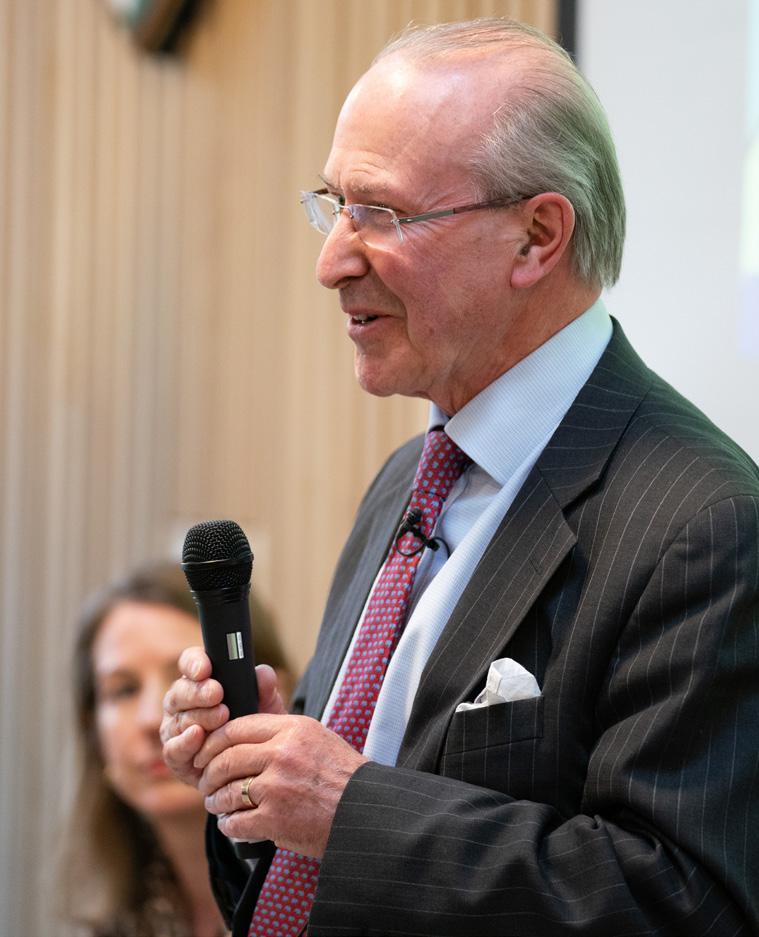

The Global Centre on Healthcare and Urbanisation (GCHU) seeks to explore ways of making cities and towns more environmentally, economically, and socially sustainable, and to promote urban environments that support and sustain health and wellbeing.
The GCHU is co-directed by Dr David Howard and Professor Carl Heneghan, both Fellows of Kellogg. In 2021 three staff joined the Centre: Research Fellows Dr Georgia Richards and Dr Juliet Carpenter, and its Administrator, Robert Weavers. The Centre’s mission is to: undertake research and scholarship at the intersection of healthcare and urbanisation to inform recommendations for future practice; create a collaborative network that works to improve the health and wellbeing of urban populations, harnesses collective knowledge, and facilitates research; support the next generation of leaders in healthcare and urbanisation to build capacity to the highest standards; and provide and inform policy at the intersection of public health and sustainable urban development.
“Our Global Centre on Healthcare and Urbanisation is a tremendously productive
collaboration between colleagues from Evidence Based Healthcare, Sustainable Urban Development, Education, and Computing,” says Jonathan Michie.
In partnership with the University of Oxford Careers Service, the GCHU has hosted over 25 micro-internships (week-long internships, online and in person) who have explored a range of urban health topics.
The research projects include: the benefits of walkable neighbourhoods; preventable deaths in cities; changing commuting behaviour; the impact on household health of building materials; fuel-poverty, and zero carbon homes.
In recognition of the success of the programme, the Centre was awarded a prestigious Gold Standard Internship Host Award for 2021 by the University of Oxford.
Interns have completed topical research reviews, published blogs, co-written reports, and had a publication accepted in the British Medical Journal (BMJ) Evidence Based Medicine. Other outputs include published reports on walkable neighbourhoods, and preventable deaths involving cyclists.
Jessica De La Haye, who is studying Human Sciences, says, “I learnt so much
about qualitative research methods and data management during my week. It was fascinating to see how we could take these data-rich reports, analyse them, and synthesise the findings in a way that could have real policy implications. The internship was fast paced, engaging, and incredibly informative.”
In October 2021, the GCHU was very happy to re-launch the popular Healthy Cities Public Seminar series, in partnership with The Prince’s Foundation. These twice-termly gatherings (5pm Wednesdays, Weeks 1 and 8, in The Hub), preceded and followed by refreshments and food, bring together a range of practitioners, academics, students, local government representatives, and members of the public interested in cities and city-living.
Subjects explored to date include artificial intelligence and urban health, the role of the built environment in creating healthy cities, and how to encourage cycling as a healthy, sustainable, and safe mode of transport.
The Centre made the decision not to hold the seminars online during the pandemic. The essence of these public meetings has always been to gather in a room, discuss,





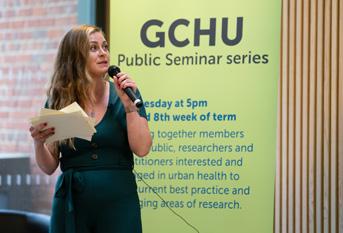
argue, and enjoy a sociable evening together at College. All the seminars, however, are also filmed and available to watch later online via the GCHU website.
Inspiration for the Centre’s new research project on Oxford’s Low Traffic Neighbourhoods, funded by the University’s Medical Sciences Division, came as a direct result of lively conversations at a public seminar on that topic.
This year in July, the GCHU will be at the Venice Biennale, and will host a summer
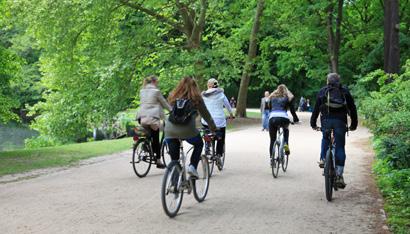
school on sustainable, healthy cities with the European Cultural Academy. Later in October, the Centre will welcome colleagues and students from the University of Grenoble to the College, for another week of workshops, events, and activities around the theme of sustainable urban living.
Designing and building healthy cities requires innovative ideas, technical skills, but also sound funding. With this in mind, the Centre hosts a conference on sustainable finance each autumn with leading practitioners in green capital.
Anyone is welcome to join in any of the activities mentioned, such as the twicetermly public seminars. If you would like to visit the Centre itself, please get in touch. You can also sign up to the GCHU’s mailing list via www.gchu.org.uk
Students are welcome to apply for one of the Centre’s regular micro-internships, or the new month-long summer internship, via the University’s Careers Service.
The GCHU team are always keen to hear from alumni who may wish to get involved.
The Bynum Tudor Fellowship is the highest honour the College can bestow. Prince Charles is one such Bynum Tudor Fellow, and another was the late Desmond Tutu, who died last year. Here we celebrate his memory.
On hearing the news of Archbishop Tutu’s death, Professor Jonathan Michie paid tribute: “He was a wonderful friend and supporter of Kellogg College, who loved talking with our students. He filled any room with energy and warmth.”
The late Archbishop Desmond Tutu (1931-2021) was elected to a Bynum Tudor Fellowship in 2010 and visited Kellogg that year. He delivered the 2010 Bynum Tudor lecture and drew from the experience of overcoming apartheid to point the way to justice and reconciliation in the Middle East. His lecture was entitled ‘Lessons from the truth and reconciliation process for 21st century challenges’.
He encouraged all those who heard him to take an interest in justice and reconciliation, and to play an active part in these issues. The Chancellor of the University of Oxford, Lord Patten, hailed the Archbishop’s contribution to truth, justice, and reconciliation as one of the historic moments of our time.
Archbishop Tutu was a Bynum Tudor Fellow from 2010-2021.
The Archbishop and the Flying Colours
Navlika Ramjee, Kellogg’s first MCR president, recalls her meetings with Desmond Tutu and Prince Charles.
“The Flying Colours artwork, made of two canvases, one above the other, is for many people the first thing they see when they enter Kellogg College. It is a digital print on canvas, an edition of one. The Reverend Tutu was most certainly an edition of one. I commissioned this piece to commemorate this great Bynum Tudor Fellow and to ensure that his role as part of our story is made evident to all who visit.
“At the time, Kellogg was in its new premises and the walls were clean and mostly unadorned. That was about to change.
“I did not know the Most Reverend Desmond Tutu except by reputation. Meeting him was an exciting prospect for



me, being a fellow South African by birth. My heritage is Indian and I am a British citizen, but Table Mountain lives in my guts and sky blue skies fill my heart. The idea of commemorating the visit of the Archbishop of Cape Town felt important.
“I engaged the artist Tom Kemp to create a large work. He made digital art and this struck me as an appropriate way to reflect our ideals of moving into a fairer future. I asked that the colours demonstrate inclusion and be taken from the South African flag. Flying Colours was created in a software universe. The canvases are snapshots of the movements of these charged colours before and after they meet. It was delicate, colourful and fun. If you stand before it you can follow the trails as they tangle and crash and embrace, much like we do. It can also represent a before and after apartheid scenario. But as a representation of inclusion it is most powerful.
“The Archbishop unveiled the work and the artist gave a talk about the creation of it. He talked about the software and how it was used to show the many heraldic colours of this vibrant new South African flag. After which we went in to have dinner.
Lucky me to be seated at the same table as Archbishop Tutu. And how unfortunate that there is no photographic record of the event! However, Archbishop Tutu can be seen giving his Bynum Tudor Lecture on YouTube. I was there, lucky me again. And I would urge you to watch and listen.
“His Royal Highness Prince Charles is also a Bynum Tudor Fellow at Kellogg. For his visit to us, some of the emeritus Bynum Tudor Fellows were there to welcome him. And so was I. I was chosen to represent the absent Archbishop. What can I say but “lucky me”? With my hands together and a slight bow of the head, I greeted the Prince with a namaste. Best pandemic choice, I thought. We talked briefly about the wonderful man who was Desmond Tutu, about the canvases and about Kellogg’s ideals for inclusion. He made me laugh out loud, although I don’t remember how.
“I am very happy that we have Flying Colours flying boldly in our corridors and in our ideals, and especially to celebrate and sustain the memory of the Most Reverend Archbishop Desmond Tutu of Cape Town, South Africa and of the world.”

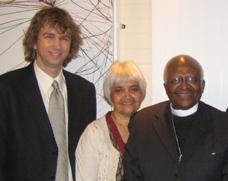
A high
The Bynum Tudor Fellowship was established in 2004 as part of the College’s mission to engage with influential thinkers and experienced practitioners in business, policy making, and culture. The Fellowship is named in honour of the late North Carolina community leader Bynum E Tudor Jr and Mrs JoAnna Tudor, both generous supporters of Kellogg.
Our current Bynum Tudor Fellows
Lord Karan Bilimoria CBE
Sir David Brown
Lady Sylvia Jay
Dr Marcy McCall MacBain
Dr Phumzile Mlambo-Ngcuka
HRH The Prince of Wales
Lord David Puttnam
Dr Bryn Roberts
Sir Hector Sants
La June Montgomery Tabron
Dr Ralph Walter
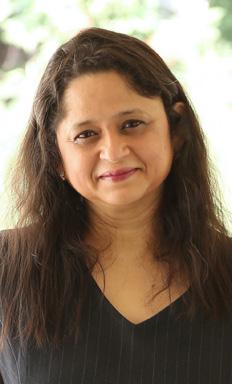
What prompted you to choose Kellogg?
When I matriculated in 2013, I was 39 years old. I had heard that Kellogg had the highest number of part-time students and I was keen to meet lifelong learners like myself.
What inspired you to choose your degree programme?
My Oxford Masters came almost two decades after my undergraduate degree in psychology. I had been a journalist for 10 years and then worked in various leadership positions in Mumbai, Pune, New Delhi, and London. Every role had offered challenges, complex, wicked problems that helped me evolve as a professional. However, for the first time
in 2013, I felt my job was predictable, easy, and alarmingly, I had stopped learning. The MSc at Oxford came after a long search and it was precisely what I was looking for – a rigorous, structured, taught course with intense pre-work, post assignments for two tough years and then a dissertation. My cohort of 44 comprised 17 nationalities and just six women. Undoubtedly, I was delighted to be accepted into the programme.
What have you been doing since graduation?
I remember sitting next to one of my favourite teachers, Professor Bent Flvbjerg, at dinner before our first lesson. He asked me what I was expecting the two-year programme to do for me. I replied that I was hoping it will help me change my life –and it did!
Even while I was at Oxford, I quit my job and started my own company called Elephant Connect in leadership training and project consultancy, which was profitable in the first quarter. I then took on an assignment as a CEO of an 11-year-old company in the area of large corporate social responsibility (CSR) projects and employability training. After a threeyear successful stint there, I took on a turnaround project for the first time – for our own charity, Maya CARE. The charity was established in 2009 by my husband Abhay Joshi, my late mother Dr Vidya Gokhale, and me, to serve the elderly in their own homes and care homes. For the first 11 years of its existence, Maya CARE was funded through our own salaries. When I quit my job as CEO in March 2020, there were two options – Maya CARE dies due to the dwindling earning capacity of its founders. Or else, we build a team capable of running Maya CARE without its
Degree course: MSc in Major
Programme Management
Matriculation year: 2013
Year of graduation: 2015
funders. Since May 2020 I have channelled my energy towards nurturing a team of people with disabilities to lead Maya CARE and raise funding. Today, we serve the elderly in four UK and 30 Indian cities, have completed 10,500 visits to the elderly, and have 100 people with disabilities on board, including a team of 30 emerging leaders. We have an audacious dream – of serving the elderly in every city of the world with a helpline in every spoken language, managed by a person with disability in that country.
There are some aspects of my time at Oxford that are with me every moment of my work life. It is fascinating that the same concepts are applicable to problems in far flung rural India, among underprivileged students and of course in my own team of leaders and professionals with disabilities.
I have discovered and accepted that I am immensely gratified by witnessing the success of someone who I may have managed to influence positively. My future work will continue in nurturing leaders. I am also working on my sixth book.
When I stepped into Oxford, I shed the constraints of my prior experience and the blinkers of what I thought I knew, and just chose to stand beneath this colossal spring of knowledge and soak in its fragrance. Apart from the wealth of knowledge in its classrooms and reading material, I was able to learn from everything and everyone around me – how should institutions be managed, how should application forms be designed, how should assignments be assessed. The Oxford fountain flows on.
To mark Black History Month at Kellogg, Kellogg student Urvi Khaitan (DPhil Economic and Social History) curated an exhibition on some of the first black women students to study at the University of Oxford. Here she describes her search for the University’s pioneering black female students, who have remained almost invisible – until now.
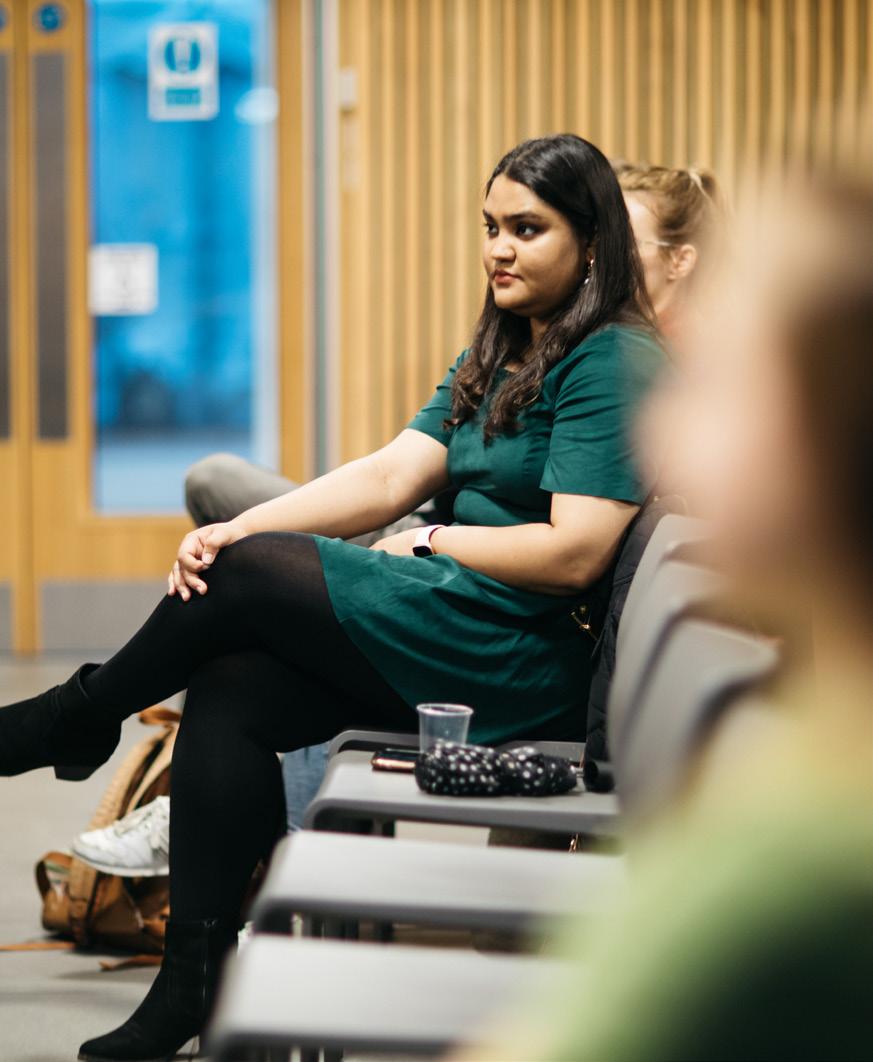
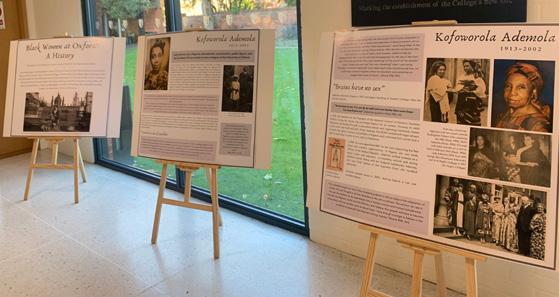
Walking around Oxford and through its colleges and libraries can sometimes be a discomfiting experience. As an international student from India, I’ve often been struck by how different Town – a city buzzing with a highly diverse and international population – can feel from Gown, and its buildings full of portraits and pictures of people that reflect little of what the Oxford student body looks like today.
Women of colour have studied at Oxford since women were allowed to enter the University, but for an institution that takes pride in celebrating its many ‘firsts’, there is surprisingly limited attention given to its first female students of colour, barring a few instances. I found that portraits and plaques were too few and far between, and so in my spare time I started digging for stories, in search of women whose journeys I could relate to at least a little better than the people whom I saw framed on the walls around me.
After a conversation with BAME Fellow Dr Shreya Atrey about drawing on some of my research for Black History Month at Kellogg in October 2021, I had the idea of doing an exhibition on the first black women students to study at the University. Putting together an exhibition, rather than a talk or a seminar, stemmed from a wish to be able to see visual representations of women of colour occupying a physical space in Oxford. It seemed fitting, in a sense, for Kellogg to host that exhibition, seeing as it was until recently the youngest college at Oxford, and is the most international.
Considering its incredibly long history, the University of Oxford opened its doors to a more varied student body only relatively recently. The Universities Tests Act in 1871 allowed non-Anglicans to study here for the first time. While women began studying at Oxford from the establishment of the women’s colleges in the 1880s, it was not until 1920 that women began to be awarded degrees. Black female students began arriving at Oxford to study at the women’s colleges from the 1930s. It took until 1974 for maleonly colleges to begin admitting women.
The exhibition ‘Black Women at Oxford: A History’ focused on four women – Kofoworola Ademola (née Moore), the first black African woman to achieve an Oxford degree; Merze Tate, the first African-American woman to do so; Florence Mahoney, who did a
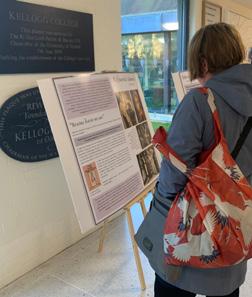
masters at Oxford and a PhD at SOAS, becoming the first Gambian woman to earn a PhD; and Karen Stevenson, the first AfricanAmerican female Rhodes Scholar. It used photographs, writings, and biographies to bring to life their unique journeys, struggles, and experiences at Oxford and beyond. The exhibition was limited in its scope as it focused on the ‘firsts’; the thousands of women of colour who have come since have also indelibly reshaped the University. I must also acknowledge my own positionality –as a brown woman born and raised in India, I cannot begin to comprehend the experiences of black women students at Oxford. Reading memoirs and recollections of their time spent at Oxford was illuminating. Kofoworola Ademola, recalling her early days at Oxford, wrote:
“I had never felt as out of place and as homesick in England as I felt in the first two weeks at Oxford. I seemed tossed in a sea of intellect with highly earnest students who were themselves occupied in trying to emerge from the surging whirl. But gradually I discovered we were all aground on dry land and that I was among a sympathetic crowd. I was particularly struck at first by the incessant thirst of the students for information... the Oxford student is never satisfied until he has searched out how a thing came into being, how it is functioning, and what is its future objective.”
K A Moore, ‘The Story of Kofoworola Aina Moore, of the Yoruba Tribe, Nigeria, written by herself’ in Margery Perham (ed.), A Collection of Life Stories: Ten Africans (1963; first published 1936), p. 332.
Her time in England was not entirely smooth. Later on in the same account, she said:
‘‘What is far more exasperating than the more acute form of colourprejudice is being regarded as a ‘curio’ or some weird specimen of Nature’s product, not as an ordinary human being…”
Ibid, p. 339.
Ademola was doubly marginalised by her race and her gender, but she had also been raised in a privileged Nigerian family. I found it helpful to view these women through an intersectional lens, making it possible to think about multiple overlapping modes of discrimination and privilege in each of their cases. While some were

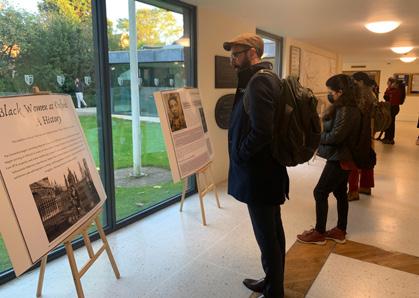
relatively privileged in terms of class and socio-economic status, making it possible for them to read for a degree at Oxford, in other cases, class served as a further barrier to access.
Merze Tate was a highly influential academic and expert on diplomacy and international relations, yet she was marginalised in
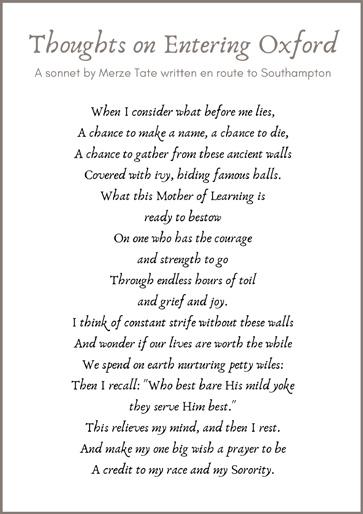

conventional histories of Anglo-American international theory. Over the last few years, scholars have increasingly turned to her ideas and have been writing about her life, thought, and intellectual legacies. A seminar room in Oxford’s History Faculty building on George Street has been symbolically renamed after Tate. The room used to be named after Hugh Trevor-Roper, the Oxford historian who was famously dismissive of African history prior to European colonization. Mahoney, an eminent academic also featured in the exhibition, directly challenged such problematic notions by publishing work that centred local forms of resistance and agency in the Gambia.
The legacies left behind by Oxford’s first black women students, both within and beyond the University, are of immense significance – but they require greater attention and focus. Working on the exhibition was an eye-opening experience. Much more remains to be done at Oxford to increase access and opportunity.
On a personal note, I have found myself going back again and again to a moving sonnet written by Tate en route to Southampton, on her way to beginning her master’s degree at Oxford (shown left).
Notes:
Pamela Roberts’ Black Oxford: The Untold Stories of Oxford University’s Black Scholars (2013) offers valuable insights into the lives of several black scholars.
The exhibition was made possible by help and support from Shabaz Hussain, Events Officer, and Shreya Atrey, BAME Fellow. ‘Black Women at Oxford: A History’ was featured on BBC South on 21 October 2021.
For Black History Month, Dr Jason Arday was invited to give Kellogg’s Black History Month Lecture. You can watch his lecture in the news section of the Kellogg website at https://www.kellogg.ox.ac.uk/news/inaugural-black-historymonth-lecture-watch-the-film/
For Vincent Strudwick, an early member of Kellogg, the new College became a kind of second home, a place of belonging that he has shared over the years with many like-minded people. His wish is that it should be available for future generations, and this is why the newly established society named after him celebrates all those who have so generously decided to leave a lasting legacy to Kellogg in their will.

As the first college to support part-time study within the University, Kellogg’s mission from the outset has been to open up the Oxford experience to a wider audience, regardless of their background or financial circumstances. Today, as work, worklife and workplaces change, we want to continue to make a difference by significantly increasing numbers of both our part-time and full-time students, so
even more people can benefit from the Kellogg experience of studying at Oxford.
Legacy gifts are vital in helping us achieve that goal and as a way of showing our appreciation and thanks we founded the Vincent Strudwick Society to celebrate the generosity and far-sightedness of our living legators. Every single gift we receive helps transform lives and champion lifelong learning for generations to come enabling us to offer a wide range of scholarships, including our first fully endowed scholarship, and a variety of bursaries to assist students’ time while at Kellogg.
The Rev Canon Dr Vincent Strudwick was one of Kellogg’s earliest members and has witnessed the College’s life-changing impact first-hand over the years. He is now an Honorary Fellow and Emeritus Fellow of the College. Here he describes what Kellogg has meant to him and explains his fervent hope that its legacy continues long into the future.
“When Geoffrey Thomas, Kellogg’s founding father, envisioned a new College in Oxford University, he asked the question:
“What kind of role is there for a College of international character, including part-time as well as full-time students, that enables ‘belonging’ in an adult way, enhances friendships across disciplines, and provides a framework in which there is the setting for achievement in specialist
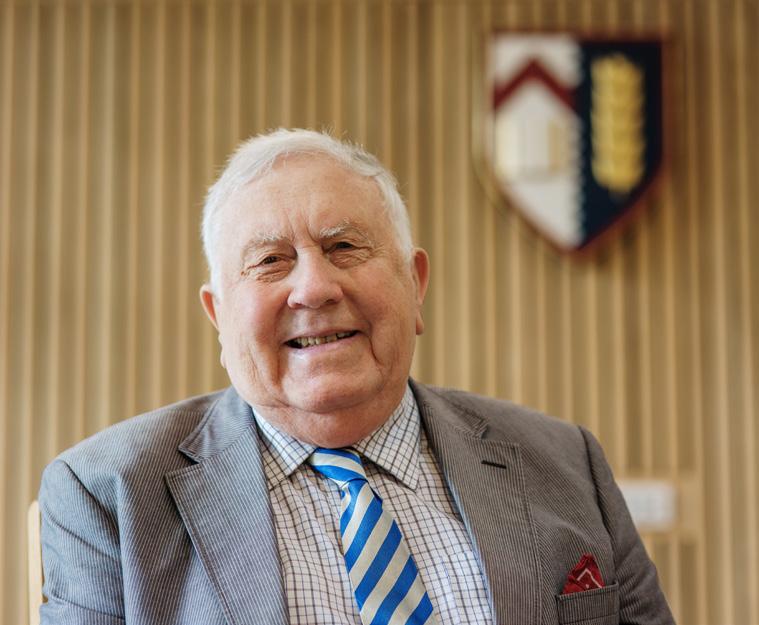
knowledge, but also the opportunity to reflect and grow in wisdom and maturity?”
“It was a question he shared with the dozen or so founding Fellows as he set about establishing a distinctive culture and regime with our first students.
“We were all conscious that our project was ‘counter-cultural’ but actually in tune with a long tradition of change in the life of the University. What evolved was growth in numbers, an initial establishment of buildings, the fostering of relationships with other Colleges, and above all the exploration of the nature of ‘belonging’.
“Belonging happens. We belong in a family, and as we grow, ‘join’ groups to which we belong in a variety of ways,
involving differing degrees of commitment. It was our task to establish a sense of ‘family commitment’ in which the Fellows and administrative staff provided the personal foundation for an expression of ‘community’ that would act as a life forming experience for our students.
“The word ‘education’ comes from the Latin ‘educare’, a word used by the Romans to mean ‘muck spreading’, a process to encourage growth. Geoffrey realised we needed a radical social programme to enable this to take place.
“We all came from very different backgrounds – academic, ethnic, faithbased, agnostic, atheist; and had a variety of personal households. How should we
explore the dignity of difference and learn from it? The Fellows began to work it out together.
“Our family households eating together, combining food and drink with relaxed conversation and laughter, was a priority. The new College flourished and grew. When I became Chamberlain, we explored a distinction between ‘College’ Night dinners and ‘Guest’ Night dinners. The former were to enhance our togetherness while the latter enabled us to mingle with those from other Colleges and with friends, to solidify our corporate nature, exhibiting and enjoying our distinctive values.
“By the year 2006, there was an increased sense of ‘busyness’ and we saw
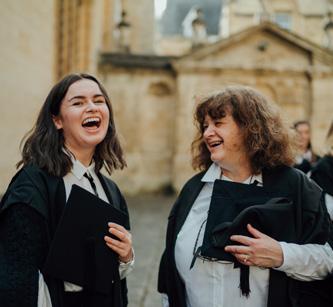
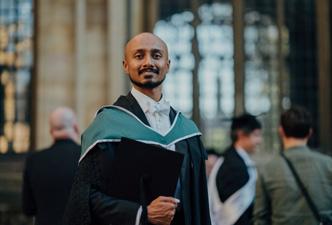
the biggest change in our history so far take place when we acquired a four-acre site on the Banbury Road. We established a new mix of some residential international students alongside the part-time students, integrating them in the life of the new College.
“In 2008 Geoffrey retired, and was succeeded the next year by an economist and director of the Birmingham University Business School, Professor Jonathan Michie, who had the challenging task of affirming what Kellogg stood for, in an increasingly competitive, rapidly changing Oxford. He was now to put his own imprint on it, reimagining our role and how to implement it in a global culture.
“It was not just Oxford that had changed, but change was part of the new world. As Professor of Innovation and Knowledge Exchange, Jonathan was keenly aware of the dangers as well as the possibilities of a world where the movement of peoples and the power
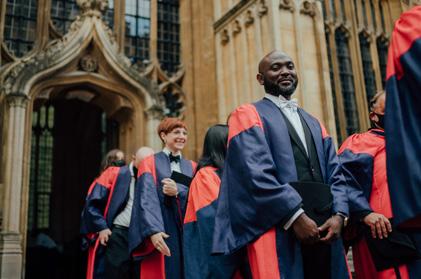
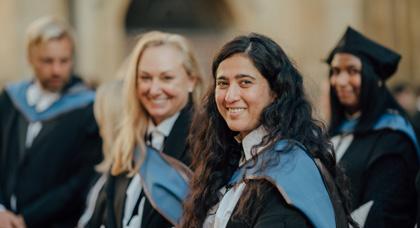
of capitalist global institutions brought economic hardship and inequalities and injustices for peoples far and wide.
“He believed that with increasing social division and unrest, and the imminent dangers of climate change, there was need for a new green deal with a College for scholars in a multitude of disciplines, who would learn to think global and act local.
Fundraising and recruitment followed, with the acquisition of adjacent buildings and land to accommodate an influx of such students.
“We live in a period of political economic and social division arguably unparalleled since the fall of the Roman Empire, and exacerbated by Covid-19. The issues that face the world need those of us who have found meaning and purpose in the Kellogg vision to combine as former Fellows and students and be part of a transformation capable of making real changes in the site and its environment. Hence the creation of this legacy society that bears my name.
“As a Fellow from those very early days in 1990, and now approaching my 90th year, Kellogg’s vision has provided me with a place to feel at home and to grow. There is no such place as an ideal home, but I certainly found Kellogg to be a second home, in which I could share a vision in company with people of like mind, and which I long to be available for future generations.
“It is an enormous challenge to embrace yet more change, but in such times of uncertainty Kellogg and its students fill me with hope as they seek to change the world for the better. May they do so for you.”
If you would like to find out more about leaving a gift to Kellogg in your will or the Vincent Strudwick Society, please get in touch with Kellogg’s Director of Development and Alumni Relations, Rebecca Baxter: rebecca.baxter@kellogg.ox.ac.uk
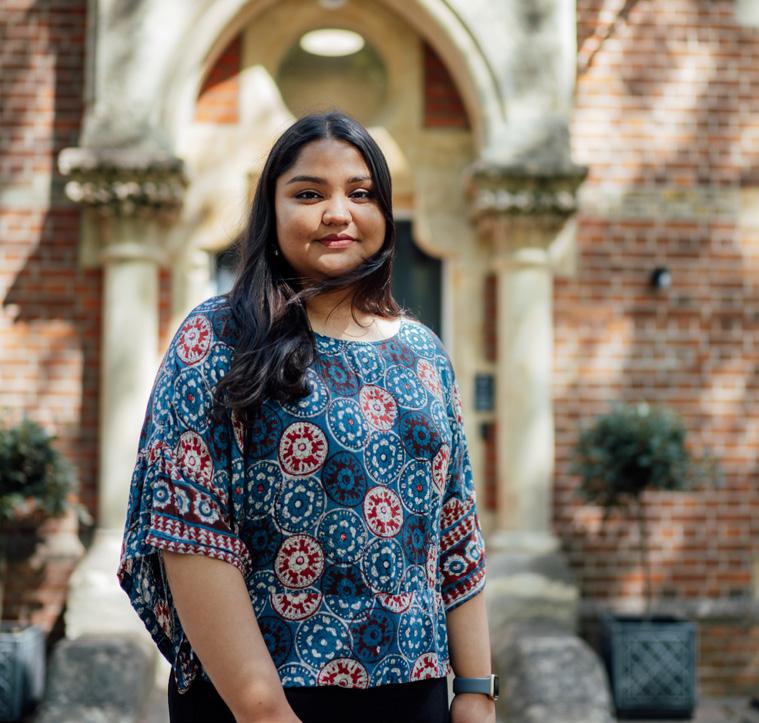
“I feel very honoured to have been awarded this scholarship and I would not have been able to pursue a doctorate at Oxford had it not been for the scholarship’s generous financial support. The security and stability provided by the scholarship have meant I have had all the freedom in the world to think, to question, and to expand my horizons.”
Urvi Khaitan is studying for a DPhil in Economic & Social History and is the current holder of the Oxford-Vincent Packford and Geoffrey Smart Graduate Scholarship - a scholarship only made possible by the generosity of Kellogg’s supporters.

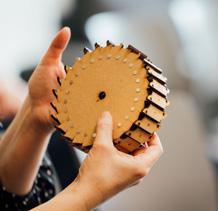


During the first UK lockdown, Kellogg Fellow Dr Reuben Binns built a replica WWII Enigma machine at home. Here he describes both the arduous work involved and what he learnt about both electromechanical computing – and modern IT security.
As the storm clouds of World War Two gathered over Britain, brilliant minds worked tirelessly at Bletchley Park to break the German Enigma cyphers. The secret intelligence unravelled by codebreakers was vital to the war effort and is thought to have shortened the conflict by years.
Bletchley Park became the birthplace of modern information technology. Its extraordinary legacy still impacts on us today and resonates through the Artificial Intelligence and cyber security research undertaken by members of Kellogg.
Each year we celebrate our unique partnership with Bletchley Park through a programme of events, most of which are open to the public.
In March, Kellogg Fellow Dr Reuben Binns (Associate Professor of Human Centred Computing, Department of Computer Science) demonstrated his own Enigma machine which he built at home during the Covid-19 lockdowns. Here he talks to us about why he decided to make an Enigma machine and what the process taught him about electromechanical computing, security, and usability.
“During the first lockdown of 2020, I needed a distraction. Something that took me away from the computer screen, and ideally something creative with my hands. I have been interested for a while in the history of cryptography and thought it might be fun to have a go at building an Enigma machine.
“The original Enigma machine was invented in the 1920s and was used extensively by Nazi Germany during the Second World War. It uses a combination of mechanical rotors and electrical circuits to scramble a secret message into a ‘ciphertext’ – a series of apparently random letters. When you press a letter on the keyboard, the corresponding ciphertext letter lights up on the lamp board (and vice-versa for decryption). If the ciphertext is intercepted by an adversary, they can’t decrypt it unless they know the precise settings of the sender’s machine. This means the message can be sent over an insecure channel like radio.
“I decided to break this slightly daunting project into smaller chunks. First, I made
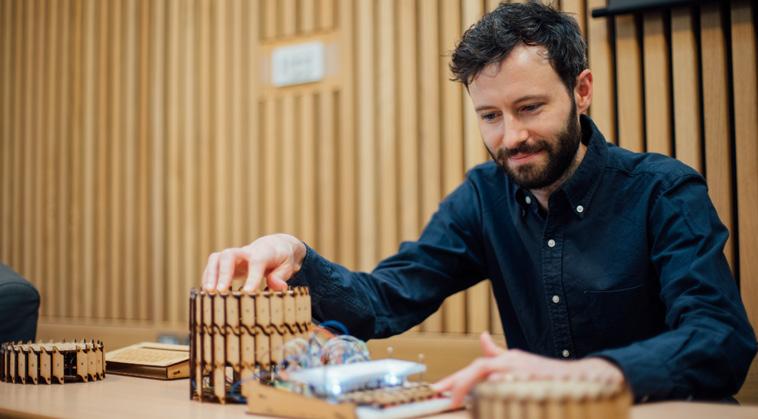
the basic mechanism which turns the rotors around as the user types each letter, but left out all the electrical components. I used spare pieces of MDF and cut them into gears, ratchets, and pawls using a hand saw. The mechanism worked to push the rotors around like the original Enigma, but only just. I realised I wasn’t going to be able to make something precise enough by hand.
“So I went back to square one and began designing a new, complete, electrico-mechanical system. This time, I wanted to make a fully functional replica of the Enigma, featuring rotors that actually conduct electrical current, along with the keyboard, lamp board, and plug board. For this to work, I needed to get much more precise, so rather than hand-cutting parts, I designed it all using computeraided design software and sent it off to a workshop to have the parts cut out of thin MDF with a laser cutter. I also took advantage of something Engima’s original manufacturers didn’t have: cheap, reliable modern electronics components. While there has been an ongoing global shortage of integrated circuits since the pandemic,
these components are so ubiquitous I had no trouble sourcing them.
“The parts all slot together without any glue or screws, so it can be put together by hand. It does require some patience though: each of the three rotors contains 52 contact points which need to be connected by jumper cables and take around an hour to assemble. I also had to redesign the keyboard, lamp board, and plugboard several times to overcome the jumbled mess of crossed wires.
“This project was a good way to unwind after work, but also prompted me to reflect on my research.
“First, I teach a course on the human side of computer security, and one of the things I stress to students is that a system can be secure in theory, but to be secure in practice it needs to be usable. Just as with modern computers, people struggle to remember dozens of complex random passwords, and the operators of the Enigma machine didn’t always follow the correct protocol; this weakness was exploited by Bletchley Park.
“Second, this project gave me a handson understanding of the power and perils of electromechanical computing. Modern
digital computers represent the world in terms of 1s or 0s, and nothing in between. The Enigma machine requires the position of the rotor to be in exactly one of twentysix positions, and nothing in between. The difficulty is that most of the physical world is continuous, so things are generally along a sliding scale between states. This makes it hard to model discrete states exactly. We overcame this challenge with modern computers by using transistors, which force electrons to either flow (representing a 1) or not (representing a 0). But when you use a mechanical component to represent a state, like with the Enigma machine, you need very precise engineering. If the rotors turn a little bit too far, and slip out of place relative to each other, the machine will eventually make an error. I learned this lesson the hard way, giving me a newfound respect for the designers of mechanical and electromechanical computers, and gratitude for modern transistors that we all depend on today.
“I’m now designing the second version of this machine, which I hope will be more robust, reliable, and simpler to put together.”
“This project was a good way to unwind after work, but also prompted me to reflect on my research”

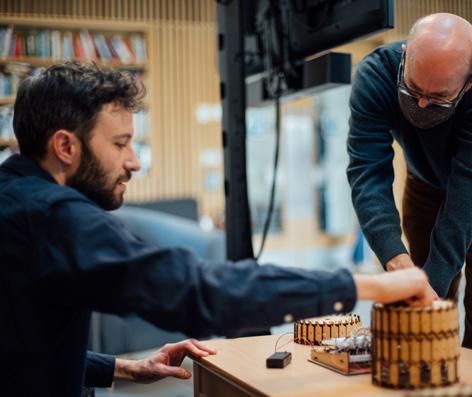

“Although Kellogg College was founded long after the codebreaking work at Bletchley Park finished, we have many links. Our annual Bletchley Park Week is a great reminder of the power of applying both intellect and hard work to urgent and difficult problems. It also illustrates the contemporary application and leading-edge research of much of the work that originated at Bletchley Park.”
Professor Andrew Martin, Kellogg Fellow and Trustee of Bletchley Park, is Professor of Systems Security and Director of the Oxford Centre for Doctoral Training in Cyber Security.

Sir David Brown: Bynum Tudor Fellow and Chairman of the Bletchley Park Trust.
A prominent figure in the telecommunications and electronics industry, Sir David was Chairman of Motorola, the British Standards Institution and several industry groups, and he also chaired a number of high-level government advisory bodies. Sir David also sits on the Commission on Creating Healthy Cities, established by Kellogg’s Global Centre on Healthcare and Urbanisation and co-hosted by The Prince’s Foundation.
Professor Niki Trigoni turned her university research into a successful tech start-up, whose innovative indoor location app is helping hospitals work more intelligently. She was recently awarded Chief Technology Officer of the Year at the Women in IT Awards.

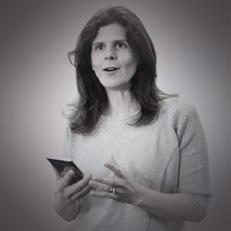
Tell us about your work and your spin-out company Navenio
I was part of the team that in 2015 developed Navenio from world-class University of Oxford science. Using only a smartphone’s sensors, a combination of four unique technologies creates an accurate indoor location, instantly providing valuable insights.
One area where Navenio’s ‘Intelligent Workforce Solution’ is being employed is healthcare, in particular at NHS sites, including Royal Cornwall, and private hospitals such as the Cleveland Clinic London.
The tech uses personal smartphones to map where people are in the hospital, and
teams can then schedule tasks depending on location and availability. Teams using the tech say it has helped to double capacity, increase productivity, and improve service levels with faster response times – all factors which lead to better patient outcomes and staff experiences. Navenio’s tech has also come into its own during Covid-19, with the app able to prompt staff to wash hands and sanitise, as well as direct resources for rapid response cleaning when necessary.
Starting Navenio allowed my group to give our research real world purpose, particularly in healthcare. The University of Oxford is one of the leading universities when it comes to spinning out successful start-
ups, and it’s where Navenio began. After two years as a postdoctoral researcher at Cornell University, I returned to the UK and established my own research group in this area, first at Birkbeck College, and since 2007 at the University of Oxford. My group’s work now lies at the intersection of cyber physical systems (Internet of Things) and machine learning. We develop intelligent and autonomous sensor systems with applications in positioning, healthcare, environmental monitoring, and smart cities. Of the various research threads, our work on infrastructure-free indoor positioning evolved into a scalable technology with broad application, and we soon saw its tremendous potential for commercialisation. With great support from the University







attendance
Dynamic prioritisation model
Dynamic assignment model
Dynamic notification Assistance function

of Oxford, and local investors, the tech was licensed to a new spin-out – Navenio Ltd founded in 2015 – and later further developed into location services for workforce efficiency.
Currently I have two roles, heading the Cyber Physical Systems research theme at the University of Oxford, and driving tech development and innovation with an amazing team of engineers at Navenio.
Oxford is widely recognised as one of the UK’s leading tech hubs and as a spin-out of Oxford University, and Navenio’s roots have been embedded in the city from the very beginning. We are proud of Navenio’s connection to the University and continue
to share financial success in the form of licensing.
As a professor at the University of Oxford, I know first-hand that the city is full of great potential and has gone from strength to strength over the past few years, despite the challenges of Covid-19. With health tech having a particularly strong presence in Oxford, we’re proud to be leveraging our work via Navenio and mitigating infection rates as well as helping hospitals become more efficient. I am certain that the future is bright for the next wave of start-ups in the city. By creating successful partnerships, the University will continue to attract the best talent from all over the world.
We’re now focussing on global expansion into the US and beyond. We want to be able to bring the benefits of indoor location to everyone, everywhere. By partnering with platforms such as HERE Technologies, we’re expanding our technological and commercial offering in industries such as healthcare, retail, and in public transport too. We’re excited about the next stage of our growth over the coming months and personally I’m looking forward to driving future innovation and developing what we do alongside our tech team. For more information visit: www.navenio.com
thought provoking, interesting, inspiring
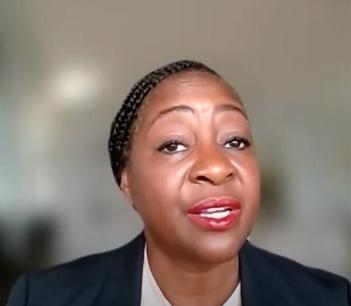
In celebration of our 30th Anniversary year in 2020, we planned an exciting series of discussions with prominent figures in politics, academia, social justice, the media, and the arts to help us commemorate this milestone. The events, ‘Kellogg Conversations’, were originally planned as in-person events to be held in the Hub throughout the year, but the pandemic had other ideas.
After postponing these events in 2020, we went digital, taking the events online in 2021. All of them are still available to watch on the Kellogg YouTube channel.
The series opened with Baroness Joan
Bakewell discussing the crucial importance of lifelong learning, followed by journalist and politician Lord Daniel Finkelstein in conversation with Lord Ian Blair of Boughton, former Commissioner of the Metropolitan Police. Other speakers included Sir Vince Cable, Geraldine Van Bueren QC and Sir Walter Bodmer.
Bynum Tudor Fellow La June Montgomery Tabron joined us online from Michigan, USA, to discuss opportunities for leadership in every circle – and how global leaders in corporations, education, civic institutions and faith-based organisations are pursuing racial healing as a path
for creating the equitable systems our children, families, and communities need.
All in all it was a fantastic, if a little late, way to celebrate Kellogg’s 30th year.
We continue to offer a diverse programme of lectures and seminars throughout the academic year, the majority of which are free and open to all. Where possible, these events are now held both in-person and online. They are also recorded, so if you’re unable to make it to the live event you can catch up online at www.kellogg.ox.ac.uk/latest/films
Some of the most interesting public figures from the UK and beyond joined us in 2021 for a series of illuminating discussions to celebrate our 30th anniversary (a little later than planned, it’s true). Scan the QR code to catch up online.
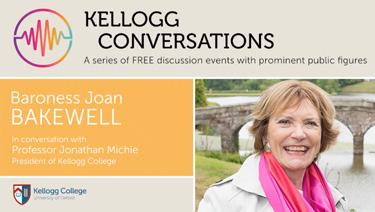

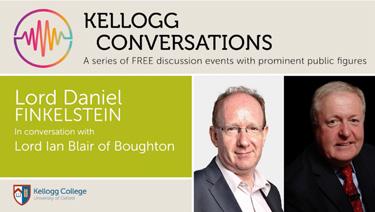

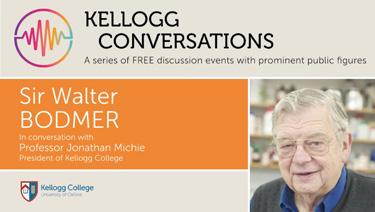

Jason King and his team have the challenging task of keeping the College buildings and grounds in top condition. He is also heavily involved in driving forward Kellogg’s sustainability plans and reducing its fossil fuel use.
How did you come to be working at Kellogg?
I previously worked for Oxfordshire County Council and when they privatised our services I decided to move on. I enjoyed looking after and working with primary schools and thought the University of Oxford would be a great fit. It took me six months to find the right post and I have been here ever since. That was eight years ago, and joining the wonderful family at Kellogg was the best move I ever made. The College has changed so much in that time and I’ve very much enjoyed being a part of that.
The Facilities team take a leading role in implementing the College’s sustainability plans. What does this involve?
The College is currently looking into the possibility of implementing air source heating on the estate. With 11 different buildings this is a large-scale project that requires a budget to match. We are also looking into the thermal efficiency of our buildings and ways to further improve the measures we already have in place. Kellogg is committed to sustainability and our focus is on removing carbon energy sources.
What issues do you face keeping our Victorian buildings and their unique facades maintained?
We have a large estate here at Kellogg. All our buildings have maintenance and
refurbishment works carried out on a rolling programme. The majority of our buildings are of a certain age, and making sure building work remains sympathetic to the original designs can eat into our budget, so we have to focus on individual properties each year. The other issue is logistics: most of our works take place over the summer to take advantage of the good weather, and emptier spaces out of term time.
What do you enjoy most about working at Kellogg?
The Estate. We encourage our College members to walk and sit on the grass, enjoy the gardens and outdoor spaces, which isn’t always the case in Oxford. We also have a lot of wildlife and biodiversity here at Kellogg. It’s just a lovely environment in which to work and I’m extremely grateful for that.
I’d also like to mention my team, John, Raul, and Shabaz, who have a great work ethic and fabulous team spirit; working with good people makes a huge difference when you walk into the office every day. The amount of work they have completed throughout the pandemic has been phenomenal and they deserve a lot of credit for their ongoing achievements.
Tell us something about you that we don’t already know.
I love the great outdoors and being outside. A lot of people at Kellogg will know I enjoy hiking, but not many will know that I also snowboard and absolutely love that. It’s lots of fun – all outdoor sports are great for body and mind, and certainly help me during busier or more stressful times.
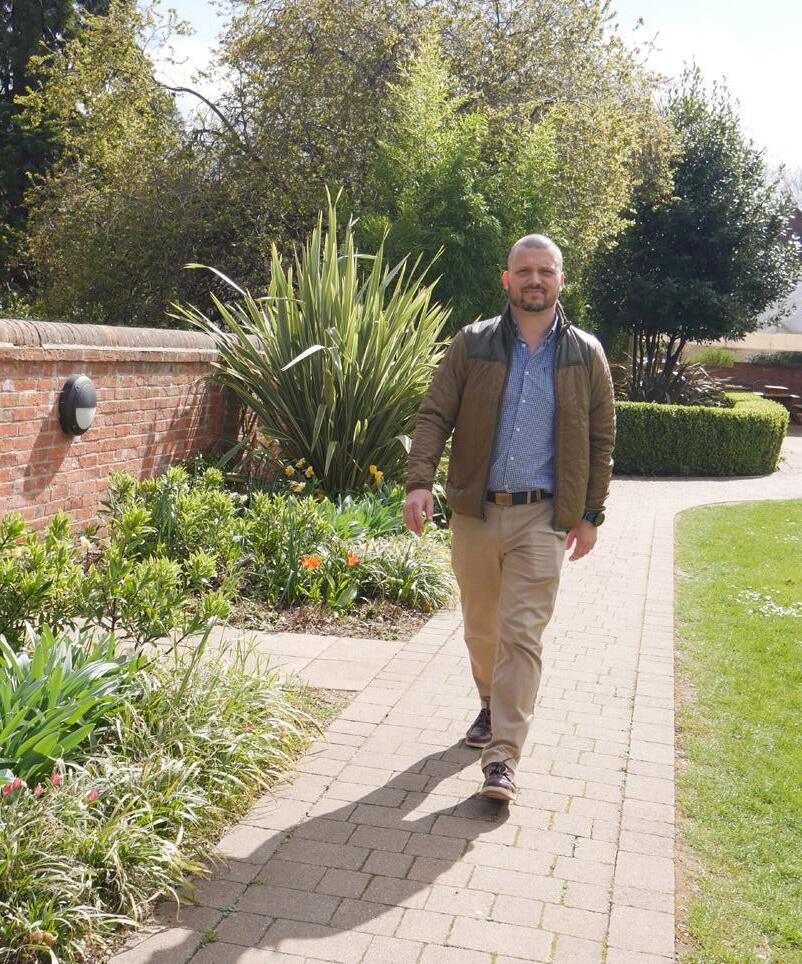
From new energy technologies to the Normans, from biography to fiction, our Fellows have written a fascinating range of recent publications.
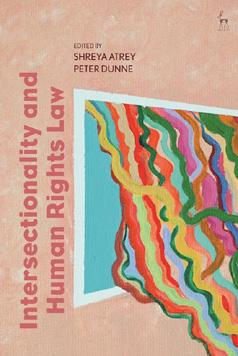







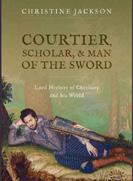

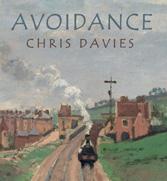
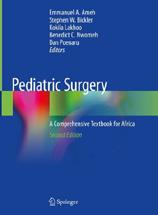

Shreya Atrey, Fellow
Intersectionality and Human Rights Law
Anthology editor with Peter Dunne. Bloomsbury 2020
A collection of essays analysing how diversity in human identity and disadvantage affects the articulation, realisation, violation, and enforcement of human rights.
Dr Anna Beer, Visiting Fellow
The Life of the Author: William Shakespeare Wiley 2021
An exciting, approachable new take on Shakespeare’s achievements as a writer within the dangerous, vibrant cultural world that was Elizabethan and Jacobean England.
Dr Antony Buxton, Visiting Fellow ‘Makers, Making, Materials’ in A Cultural History of Furniture, Volume 6, The Modern Age
Bloomsbury 2022
An examination of what modern furniture tells us about the social, political, and economic factors that shaped its form and functions.
Chris Davies, Emeritus Fellow Avoidance
Matador 2021
An engrossing tale of three women and the people they love as each one navigates the narrow path between family expectation and private happiness.
Dr James Dixon, Fellow
Energy technologies for Net Zero
The Institution of Engineering and Technology (IET) 2021
A new guide which gives a detailed look at the technologies available that can decarbonise the UK energy system – vital to reach the Government’s Net Zero targets.
Professor Jeremy Gibbons, Fellow
Algorithm Design with Haskell
Co-author with Jeremy Gibbons. Cambridge University Press 2020
A practical guide to the five main principles of algorithm design using Haskell, a purely functional language. Includes examples and exercises at the end of each chapter.
Gregory Hadley, Visiting Fellow
Critical Thinking
Co-author with Andrew Boon. Routledge 2022
Aimed specifically at language teachers, this book offers new insights and strategies for teaching critical thinking skills in ways that will motivate and engage learners.
Dr Christine Jackson, Emeritus Fellow
Courtier, Scholar, and Man of the Sword: Lord Herbert of Cherbury and his World
Oxford University Press 2022
The first full account of this flamboyant Stuart courtier, soldier, and diplomat who acquired a reputation for duelling and extravagance but was also a leading intellectual of his time.
Dr Yasmin Khan, Senior Tutor and Fellow
Edgware Road
Head of Zeus 2022
This debut novel is a gripping mix of mystery, family drama, and insights into the immigrant experience, depicting two generations of a London Pakistani family.
Professor Kokila Lakhoo, Fellow
Paediatric Surgery 2nd ed, Chapter 13 Global Surgery
With Neema Kaseje, Niyi Ade-Ajayi, Jerome Loveland and Chandra K. Sinha. Oxford University Press 2021
An examination of paediatric surgery in a global context – a new chapter in the second edition of this valuable handbook.
Professor Gary Lock, Emeritus Fellow
Atlas of the Hillforts of Britain and Ireland
Edinburgh University Press 2021
The first comprehensive series of maps of hillforts from Shetland to Cornwall to County Clare, with commentaries and broader overviews.
Dr Fiona McCall, Fellow Church and People in Interregnum Britain
Editor. University of London Press 2021
A close look at the relationship between religion and society between the first Civil War and the Restoration – a period of unprecedented religious toleration and new religious ideas.
Ian Menter, Emeritus Fellow
Becoming a Teacher Education Researcher
Editor with D Mayer. St Albans 2021
Teacher Education in Russiapast, present and future
Editor. Routledge 2021
Raymond Williams and Education – history, culture, democracy
Bloomsbury 2022
A range of different examinations of education as a field of study as well as a field of practice, including a look at how to become a researcher as well as a teacher.
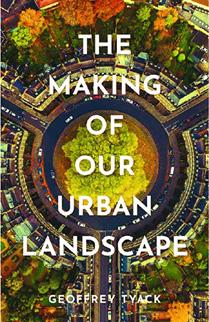
Dr. Helena Rodríguez Caro, Junior Research Fellow
Science-Me a story
Illustrator. Lilly Foundation 2021


A science book for children which contains a range of stories on everything from cells to dinosaurs. Only a few hard copies of this non-profit book have been printed but a digital version can be found on the Lilly Foundation website: fundacionlilly.com
Chris Rowley, Visiting Fellow
Changing Face of E-commerce in Asia
Editor with Abhishek Behl, Pankaj Dutta and Pratima Sheorey. World Scientific Series in Asian Business and Management Studies: Volume 1 2022 Corporate Performance and Managerial Ties in China
Editor with Ingyu Oh. Routledge 2021 Trends in Asia Pacific Business and Management Research: Relevance and Use of Literature Reviews
Routledge 2022
A range of insights and analyses of changing business practices in East Asia, including a ‘multi-level reality check’ on the prospects for transforming the Chinese economy.
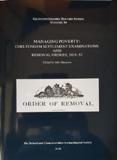
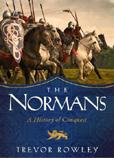
Trevor Rowley, Emeritus Fellow
The Normans
Pegasus Books 2021
Norman Landscapes
Pen and Sword 2022
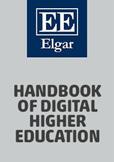


John Simpson, Emeritus Fellow
Managing poverty: Cheltenham settlement examinations and removal orders 1832-51
Editor. Gloucestershire Record Series: Vol 34
Two books looking at the energetic achievements of the Normans over three centuries, transforming from Norse invaders to Feudal overlords, before disappearing as a cultural force.
Professor Rhona Sharpe, Fellow
of Digital Higher Education
Editor with Sue Bennett and Tünde Varga-Atkins. Elgar 2022
Key findings from digital education research alongside case studies of institutional practices, considering the current and future role of digital technologies in higher education.
Recipient of the (Covid-delayed) Alan Ball Award 2020 for the best local history publication of the year, a book focusing on the introduction of the ‘New Poor Law’.
Geoffrey Tyack, Emeritus Fellow
The Making of Our Urban Landscape
Oxford University Press
A history of urban development in England over two millennia, from Roman times to the present.
The Historic Heart of Oxford University
Bodleian Library Publishing
An accessible guide to Oxford’s worldfamous architectural heritage.
Dr Carly Watson, Fellow
Miscellanies, Poetry, and Authorship, 1680-1800
Palgrave Macmillan 2021
An academic study of the vogue for miscellaneous literary collections, which changed the ways poetry was written, published, and read.
High quality rooms available including single, double, superior double/king, and twin. Shared kitchen areas and living spaces to relax in and meet fellow guests.
Flexible booking periods from short stay (nightly/weekly) to longer stays (termly) subject to availability.
Discount for College members
For more information on prices, offers, availability, and bookings visit:
www.kellogg.ox.ac.uk or email accommodation@kellogg.ox.ac.uk

“Beautiful room,clear instructions, highly recommended!”


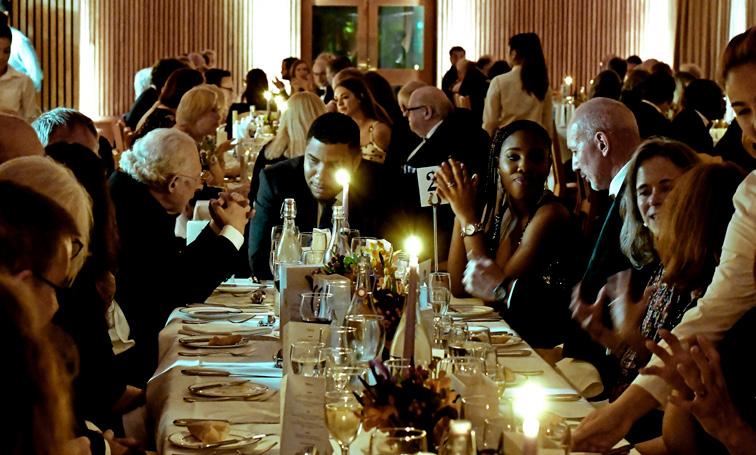


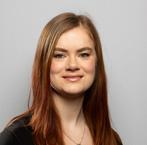
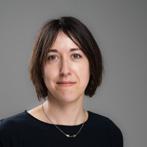

Contact: development@kellogg.ox.ac.uk alumni@kellogg.ox.ac.uk
Contact: communications@kellogg.ox.ac.uk
Launched as part of the College’s 30th anniversary celebrations, the 1990 Club is aimed at recognising alumni who make regular gifts to the College.
For more information on how to become a member, please get in touch with the Development Office at 1990Club@kellogg.ox.ac.uk
All of us at Kellogg College are grateful to our loyal supporters whose generosity enables us to deliver the best possible Oxford experience for our students – through our study and social facilities, and our range of student support funds and services. Your gifts make a huge difference by transforming futures and making a lasting impact as our students use their knowledge and skills to benefit communities around the world.
